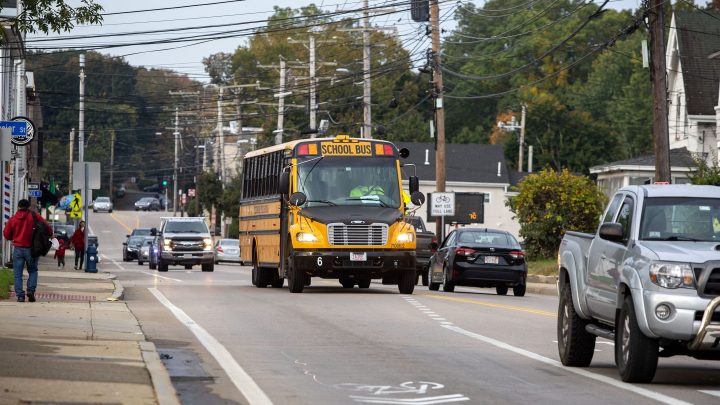
Schools turn to tech for solutions to bus driver shortage

School bus driver shortages have made a lot of headlines this school year, from stories about late-night dropoffs in Jefferson County, Kentucky, to frustration with the Chicago Public Schools system canceling yellow bus service for more than 5,500 general education students.
Schools across Massachusetts are struggling with the issue too. In Framingham, a city about 30 minutes west of Boston, the school system is short about 20 bus drivers this year, according to district officials. Not enough drivers means not enough buses and not enough space for every student who needs a ride.
This year, Framingham Public Schools had to make significant cuts to who can get transportation. Among them are kids who live less than 2 miles from school. That means many are now forced to walk to class. District leaders know the situation is not ideal, especially for young students.
“I have a first-grader, and I can’t imagine her walking 1.8 miles to school, so I get it,” said Lincoln Lynch IV, the executive director of finance and operations at Framingham Public Schools.
He said the lack of bus service is more than just inconvenient. It can also lead to increased student absences, especially on early-release days or when there’s bad weather.
“It’s really the toughest part, knowing that there are students who haven’t come to school because we cannot transport them,” Lynch said.
That’s why Lynch and his team are trying to offer families other solutions. This fall, the school district signed a deal with a tech company that runs a carpool coordination platform called CarpooltoSchool. The district pays the fees, so the program is free for families.
Kimberly Moore is the co-founder and CEO of Go Together, which runs the platform. She launched it in 2017, and now the company works with schools in 26 states.
“Go Together really is a national response to this national school bus shortage,” said Moore. “Framingham is just one of many who are looking for options that can help families.”
Over the last decade, more companies have started to offer alternative school transportation solutions, including a ride-hailing-like app called HopSkipDrive. Co-founder Joanna McFarland said she thought of the idea because she was a working parent who struggled to get her son to his after-school activities.
“I had no way of getting him there,” she said. “So it was the guilt and the frustration and the realization that there had to be a better way that led to myself and two other women to come together and create this business.”
And now, because of the worsening school bus driver shortage, the company works a lot more with school districts to transport kids to and from class.
In some ways, HopSkipDrive is similar to Uber or Lyft. Drivers can do this job in their free time, use their own cars and choose rides that fit their schedule. But this ride-hailing app is a lot more kid-focused. It only hires drivers with caregiving experience, like health care workers and former teachers. They go through rigorous background checks.
“In addition to fingerprint background checks and driving record checks, we have a whole team monitoring every ride live in real time,” explained McFarland.
The company can see how fast drivers are going or if they’re driving aggressively. If a school system has a contract with the company, the district foots the bill for the rides.
Officials with the National Association for Pupil Transportation believe companies like this will be around for the long haul, especially since there’s no end in sight to the shortage of bus drivers. Molly McGee-Hewitt, the group’s executive director, said it helps that transportation and ride-hailing apps are mainstream these days.
“We have gotten really used to using Ubers and Lyfts,” said McGee Hewitt. “And in a way, this is sort of meeting a need in the industry.”
McGee Hewitt doesn’t have concerns about any of these platforms right now, but said it’s important to have uniform regulations for any ride-hailing service that transports students. She wants this option to be just as safe as the iconic yellow school bus.
There’s a lot happening in the world. Through it all, Marketplace is here for you.
You rely on Marketplace to break down the world’s events and tell you how it affects you in a fact-based, approachable way. We rely on your financial support to keep making that possible.
Your donation today powers the independent journalism that you rely on. For just $5/month, you can help sustain Marketplace so we can keep reporting on the things that matter to you.

















